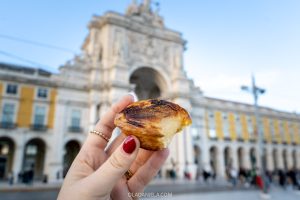If you’re a wine lover, then a cheeky road trip from Porto to the luscious Douro Valley is a must. While you can visit world’s oldest demarcated wine region on a (very long) day trip, if you have the time to spare I suggest a road trip from the city to the countryside for a few days.
It’s easy to recommend visiting the UNESCO World Heritage region, with its rolling hills and beautiful vistas. Dotted around the Douro is dozens of beautiful quintas and wine estates, some with guest rooms and infinity pools that overlook the many curves of the river, where terraced vine rolls down to the banks.
Driving directly between Porto and Régua, a large town on the banks of the Douro River, takes about 90 minutes, but there are a handful of charming stops you can make on the way, turning the drive into an adventure. Some will add a short detour, but if you have the time you can make a day of getting from the Douro Valley to Porto or viceversa.
Here are some ideas on where to stop or detour on a mini Portugal road trip from Porto to the Douro Valley, or the Douro Valley to Porto.
Need a rental car? Find the best prices using RentalCars.com or Discover Cars – both sites search and compare car rental companies including international and local rentals to find the best rates.

Contents
ToggleDrive, train or boat from Porto to Douro Valley
Yes, there are three ways to travel from Porto to the Douro Valley. The most straightforward is to drive, the slowest is to take a boat, and the most efficient is with a guided day trip. Let’s look at your options.
Driving from Porto to Douro Valley
No matter which town or quinta is your final destination in the Douro Valley, you can aim first for Mesão Frio, just over an hour from Porto. This brings you down close to the Douro River’s edge so you’ll enjoy a scenic drive taking in the steep valley’s landscapes and terraced vineyards.
You’ll need to hire a car to drive yourself, but if you’re just going for the day I suggest getting a driver/guide for the day. I’m normally a very independent, do-it-myself traveller, but the experience in the Douro Valley is just better with a guide. If you choose to self-drive it will take you lots of research to figure out which cellar doors are open and you’ll need to book tastings ahead of time.
I wrapped up some of the best winery tours to the Douro Valley from Porto here. If you’re planning to stay in the Douro Valley, you can also organise a winery tour starting there so that you can make the most of wine tastings and not have to worry about driving! TL;DR – book this top-rated small-group or private winery tour.
Ride one of Europe’s most beautiful trains
The Linha do Douro railroad is considered one of the most beautiful train journeys in Europe. The train takes about 2.5 hours to travel from Porto to Pinhão, snaking its way alongside the Douro River, past scenes of rolling vineyards and lush landscapes. Its final destination is Pocinho, a tiny town without much to do but apparently the scenery between Pinhão and Pocinho is the best of all.
To make it a scenic day in the Douro, you could book three tickets – one from Porto to Pinhão, stop for lunch and visit a winery nearby for a tasting. Then jump back on and travel to Pocinho in the late afternoon. Once at Pocinho, ride the train all the way back to Porto. You can book direct at CP for around €12 one way.

Boat up the Douro River from Porto
You can take a boat from downtown Porto up the Douro River to the town of Régua in the heart of the wine region. If you’re considering this option, know that the boat will take the majority of the day – I’m talking about 9 hours. That makes this option more about sightseeing and enjoying a slow day out on the water, rather than tasting wines.
With a boat cruise from Porto, you’ll board in the city and make your way along the Douro River, passing through a few dams on the way. This Douro Valley boat trip includes breakfast and lunch onboard, gives you free time in Régua and then sends you back to the city by bus. This Douro Valley all-day boat trip takes you deeper – dropping you in Pinhão where you’ll visit a traditional wine estate before taking a bus back to Porto. Of course, you could skip the return bus and stay in either city overnight, making your own way back by bus or train the next day.
➼ Want someone to shortcut your Portugal research? ➼ Talk to me – I offer 1:1 video calls and can plan your perfect Portugal itinerary. Find out more here.
Read next… Best Porto wine tasting tours (that I’ve done)
Where to stop on the way between Porto and the Douro Valley
The Douro Valley is a large region, not just one city. There are two main riverfront towns that most people visit to stay at – Régua and Pinhão. Rather than stay in town, if you have a car I suggest looking for accommodation at a beautiful estate or quinta out in the countryside. Many have amazing views of the river and a unique viewpoint on the rippled vine terraces that cover most hills.
If you have the budget, Six Senses Douro Valley is a 5-star beauty, or I have Ventozelo Hotel & Quinta, Quinta de la Rosa, and Quinta da Gricha on my bucket list.
Anyway, let’s dive into where you can stop on your Portugal road trip between Porto and the Douro Valley.
Related blog… Where to stop between Lisbon and the Douro Valley
Amarante: cute scenes and phallic pastries
Google Maps: 45-minute drive from Porto | 55-minute drive to Regua, Douro Valley


The first time I visited Amarante I hadn’t done any prior research. So I was surprised to peer into the window of a local bakery and see a display of huge phallic pastries! These traditional sweets are known as bolos de São Gonçalo, and the town celebrates São Gonçalo on the first week of June each year with a festival and procession, where unmarried couples exchange these pastries. Subtle!
Amarante is set on the Tâmega River, and the bridge that crosses over the river is one of most beautiful sights in town. Snap a photo then step down narrow laneways, lined with 17th-century houses, to find a pastry shop or restaurant for lunch. Amarante is within the Vinho Verde region, so it’s worth trying a crisp white wine if you sit down for a meal.
Guimarães: the birthplace of Portugal
Google Maps: 45-minute drive from Porto | 80-minutes from Regua, Douro Valley


Guimarães is known as the birthplace of Portugal. It was near this small northern city that Afonso Henriques won the Battle of São Mamede – against his own mother no less – establishing himself as the leader of the kingdom of Portugal. Its independence was recognised some years later in 1143, making him the first king of Portugal. From here, King Afonso fought his way south against the Moors, claiming land that is more or less the same borders we know as Portugal today.
Stepping into Guimarães is like stepping back in time. The entire historic city centre is a protected World Heritage Site full of architecture from the 15th to 19th centuries. As you wander up streets of large stone pavers where buildings hang over the road, it’s impossible not to wonder what life was like here in the Middle Ages. In half a day you should be able to wander through the historic centre and squeeze in a visit to the 15th-century Paço dos Duques de Bragança and the Castelo de Guimarães.
Read next… 48 Hours in Guimarães
Vila Real: the forgotten royal palace
Maps: 65-minute drive from Porto | 25-minute drive to Regua, Douro Valley
Trás-os-Montes, Portugal’s far northwest province, seems like it was once a wild, remote part of the country. These days good highways connect its capital, Vila Real, with Porto in just over an hour away. King Dinis founded the city on the Corgo River in 1289, and it became the second home of many royal families in the Middle Ages.
That means Vila Real – which means Royal Town – is home to many grand palaces, mostly built in the 16th and 17th centuries. The most famous sight is Casa Mateus, a 17th-century palace with gorgeous gardens that you can explore with a guided or unguided visit. If it makes you think of Mateus Rosé, then you’re on the money. This estate is connected with the rosé wine, which is exported around the world including to my home country Australia! There aren’t too many wines form Portugal that make it that far.
Lamego: Fancy staircase and sparkling wines
Maps: 3.5-hour drive from Lisbon // 20-minute drive to Regua, Douro Valley


Your final stop – and first taste of the Douro Valley – could be Lamego, a special town just south of the Douro River. One of Portugal’s prettiest little cities, in the heart lies a spectacular and dramatic blue-and-white tiled staircase that leads up to the Shrine of Nossa Senhora dos Remédios. Snap photos with the beautiful flight of stairs, climb to the top for views over town, then reward yourself with a glass of the local espumunte.
You could drop into Raposeira for a tasting, or try it at A Presunteca de Lamego where you can pair local vinhos with cheese and cured meats. Also in town, visit the Castelo de Lamego and Lamego Cathedral.
Lamego is also a great base in the Douro Valley. There are lots of gorgeous quintas and hotels nearby that you can base yourself at. I’ve heard that Lamego Hotel & Life is a fantastic 4-star stay, and I’ve stayed at the more budget-friendly O Cantinho do Colégio myself. Here are more ideas for where to stay near Lamego.
Don’t want to drive? There are dozens of Douro Valley day trips with very reasonable rates. Most stop at a winery or two, for a local lunch, and a little boat ride on the Douro River. If you’re short on time or don’t want to drive, this is a great option. I’ve wrapped up some of the best Douro Valley winery tours here.
Bonus stops or detours between Porto and the Douro Valley
It takes a maximim two hours to drive between Porto and the Douro Valley, so you might like to squeeze in a detour to one of these beautiful natural sites. If you left early, you could embark on a half-day hike through Portugal’s only national park, or look at ancient rock that reveals details about civilisation itself. Here are a few more off-beat suggestions that go beyond simple stops between the two.
Arouca Geopark: quiet, UNESCO natural wonder
Maps: 85-minute drive from Porto // 80-minute drive to Régua, Douro Valley


One of my favourite adventures in 2024 was a hike to an abandoned village in Arouca Geopark followed by a hearty lunch in a tiny stone village and making friends with a herd of goats. Dreamy. To add this to your itinerary would require a bit of a detour. You have to travel the winding roads within the Arouca Geopark reserve, which is most famous for the 516 Arouca Bridge.
Some girlfriends and I did the half-day hike to Drave, an abandoned village that’s a three-hour return hike from Regoufe. After I drove some rather hairy roads to Pena, where we’d pre-ordered the oven-roasted veal at Adega Típica da Pena. After, I wandered the two-street village and found myself in a pack of goats making friends and giving them scratches behind the horns. It’s a hard-to-reach spot!
Castelo de Paiva: quiet moments in schist villages
Maps: 50-minute drive from Porto | 80-minute drive to Regua, Douro Valley
Stop in Castelo de Paiva to explore a patch of the Douro River partway between Porto and the famous wine region. While the town of Castelo de Paiva is old but modest, it’s more about what you can see and do close by. I’ve heard the schist villages of Midões and Gondaróm are super cute and both sit close by to the riverside. Take the chance to visit and step back in time to see what small, remote village life was once like.
Near Castelo de Paiva you’ll also find lots of lovely river beaches and viewpoints. If you’re feeling active you should be able to rent kayaks or canoes and get out on the river. With a vessel you can visit Ilha dos Amores, the only island on the Douro River.
On the way to Castelo de Paiva, you could also stop at Castro Monte Mozinho, an archeological hilltop fortified village and castro site from the 1st century.
Parque Nacional Peneda-Gerês: Portugal’s only national park
90-minute drive from Porto to Soajo | 2-hour drive to Regua, Douro Valley

When in the north of Portugal, the remote wilderness of the country’s only national park always calls. If you’d love to explore the trails, waterfalls, lush valleys, hidden castles, and tiny stone villages of the park, then you really need more than a half-day detour on your way from Porto to the Douro Valley. You could easily spend days or a week in Peneda-Gerês and still not run out of pockets to explore, places to swim or hikes to do.
It’s hard to even give an estimated detour time as Peneda-Gerês is a huge region, much like the Douro Valley itself. If I did want to cruise through in just a day, maybe I would first aim for the village of Soajo, which is famous for its old stone corn stores. Drop into Santu’s Café & Petiscos for lunch and pass by the village of Lindoso, then cross into Spain for cheaper fuel.
Then hook down past the Cascata da Portela do Homem, a beautiful waterfall, and drive through the heart of Gerês. Finally, stop at the Cascatas do Tahiti waterfall, and pause at the Fojo do Lobo de Fafião, an ancient wolf trap. From Fafião it’s a two-hour drive to Régua in the Douro Valley.
➼ Want someone to shortcut your Portugal research? ➼ Talk to me – I offer 1:1 video calls and can plan your perfect Portugal itinerary. Find out more here.
Vila Nova da Foz Coa: prehistoric rock art
Google Maps: 2-hour, 15-minute drive from Porto | 85-minute drive to Regua, Douro Valley
For an off-beat and unusual route to the Douro Valley, you could zip across much of the region to reach the town of Vila Nova da Foz Côa. This area has evidence of life dating back to the prehistoric period, and while here you can explore some of the world’s most important rock art within the Côa Valley Archaeological Park.
Most impressive is the Museu do Côa, a modern architectural masterpiece that rises out of the landscape and houses a collection of archeological finds. From the terrace here you can also enjoy lunch with Douro River views before driving back towards Pinhão or Régua.
Need a rental car? Find the best prices using RentalCars.com or Discover Cars – both sites search and compare car rental companies including international and local rentals to find the best rates.
Did your road trip finally lead you the Douro Valley? Keep reading…
- Guide to the best Douro Valley winery tours
- 48 hours in Porto
- 22 most beautiful castles in Portugal
- 16 most beautiful villages and small towns in Portugal
- Best tiles in Porto: Where to find Porto’s most beautiful azulejos
Find other road trips in Portugal













